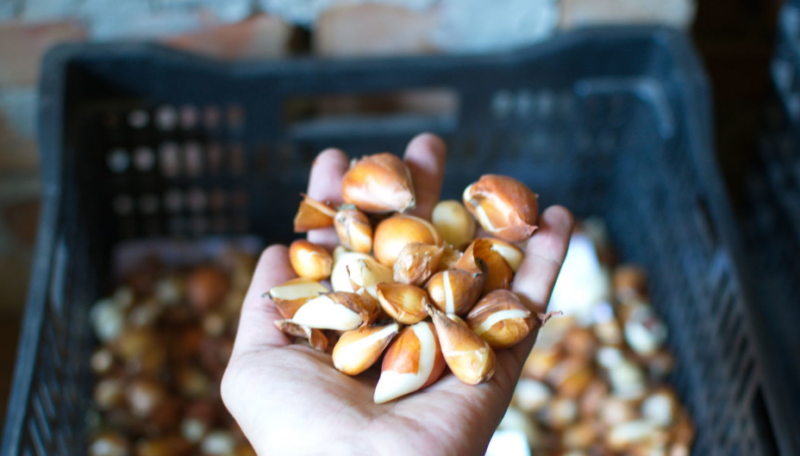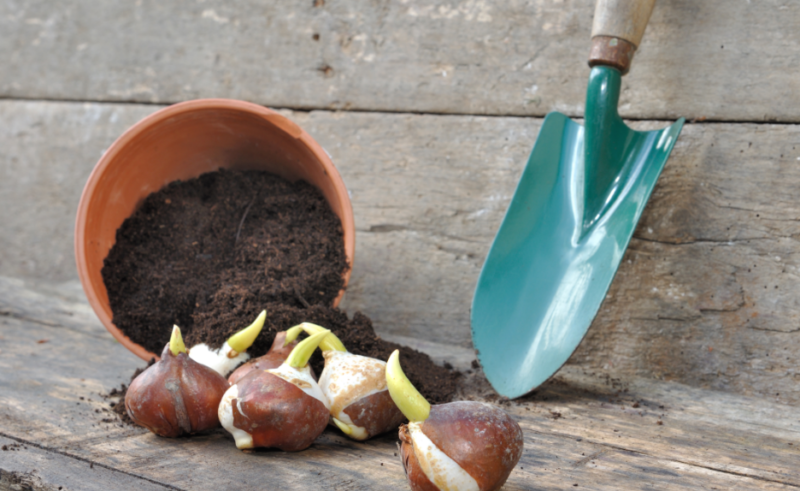Tulips - spring flowers. Many gardeners love them and plant them on their sites. But over time, the question arises when to dig out tulip bulbs and plant them again.
Material Content:
Why dig tulips
Often inexperienced gardeners think that digging them out every year is not necessary at all.
This opinion is erroneous because:
- Every year, not dug bulbs sink deeper and with the onset of spring, it becomes difficult for the sprouts to break through the thickness of the soil. This causes the stems to become weaker and the flowers to become smaller.
- Inside the bulb, when it is at rest, the formation of a flower bud occurs. In this case, the ambient temperature must not fall below 25 ° C. With strong deepening, there is a possibility that with the onset of spring the buds will not appear.
- Bulbs left in the ground form a lot of children around them. They germinate, but do not bloom. Thickness is created, the appearance deteriorates. In addition, they take nutrients from those that bloom.
If you do not dig the bulbs for the summer, various diseases affect them in the soil.
Even planting in special plastic nets does not prevent the formation of children and leads to a decrease in the size of the buds caused by natural factors.
It is important to dig varietal tulips every year. Remaining in the ground, they degenerate and eventually return to their original shape and red color.
Transplanting is also necessary to ensure crop rotation.If one culture is grown for a long time in one place, pathogenic bacteria accumulate in the earth, which develop in this particular crop.
When and how to dig out flowers
It is quite difficult to name the time when you need to do this. In the southern regions - in the early days of June, and in the northern - in the first ten days of July.
The main factor indicating that it is time to dig is the color of the remaining foliage. If it has already turned yellow, but has not had time to dry yet, the time has come. Digging bulbs is better in dry weather.
The next sign is dry husk, brown in color, like onions.
If varieties blooming at different times are planted on the flower bed, they are dug up in stages. This is necessary so that the bulbs of early varieties do not have time to deepen.
When the tulips have bloomed, do not pull them out of the ground behind the stem. It will come off easily, and the root will remain in the ground.
We dig out the tulip bulbs carefully. It is better to resort to the use of pitchfork. Try not to damage them and choose all the children from the ground, otherwise, they will clog the flowerbed.
How to store and plant bulbs in different regions
Storage rules for all regions are the same, in Siberia, in the Urals, and in the Kuban.
Unripe children are planted on the garden in the last decade of August or early September. And large ones are planted in a flowerbed in the second half of September in the southern regions, in early September - in the northern regions. If the soil is slightly frozen above, at a depth its temperature is not lower than 10 ° С.
Rules for storage of planting material
- Dug bulbs must be thoroughly dried. This will take 2 to 14 days, depending on the weather in which they were dug up. When dried, they are laid out in one layer on a fabric or paper sheet and left in the open air in a shaded place.
- When the bulbs dry, they are cleaned of the earth, the upper brown shell is removed, the dry roots are removed and sorted by size.
- Sorting is necessary to separate small and medium sized bulbs. They will not bloom in spring. For planting, a separate bed is assigned, where they will grow to the desired size. Large, undamaged specimens are planted in the flowerbed.
- The peeled and sorted tulips are stored in a dry, warm, ventilated place until autumn. Humidity in the room should be 80%, and temperature - 25 ° C above 0.
It is important that at the initial stage of storage, the ambient temperature does not drop below +15 ° C.
The material is stored in wooden crates, the bottom of which is lined with paper. From above it is required to pour a layer of wood sawdust previously calcined in the oven. Planting material is spread on top of sawdust at a distance of 2 cm.
Before planting, they lower the temperature to 15 ° C for several days, and the humidity to 70%. So the bulbs are hardened.
Planting material needs periodic inspections. This is done to remove rotten and spoiled rodents. When sprouts appear, pinch them.
Culling and processing bulbs before transplanting
Experienced flower growers know how important preplant planting is.
It includes events such as:
- husk removal;
- treatment against fungal diseases;
- sorting;
- thorough inspection;
- handling instances with minor damage.
It is required to inspect each bulb for damage, rot, infection with the disease. You should also remove the integumentary husk, because it hides infections. This is done carefully to eliminate the possibility of damage.
The bulbs that were selected for planting must be soaked for 30 minutes in a pink manganese solution. This will prevent the development of fungi. After that, planting material is planted in the ground.
If a sick or damaged specimen is found, a sore spot can be cut so as not to damage the core. It should be, like the rest, kept in a manganese solution, dried and planted in a flower bed.To prevent infection of the soil and other plants with fungal diseases, they need to be planted separately.
Landing
For transplanting tulips, you need to choose a sunny place with fertile soil. If necessary, apply organic or mineral fertilizers.
Having finished the preparatory measures, you can begin to land:
- Make grooves or holes 15 centimeters deep. At the bottom, put chopped eggshells, sprinkle it with sand.
- Bulbs from manganese and first roll in ash, then in the sand.
- Place them in the holes with the roots down at a distance of 20 - 30 cm from one another.
- Sprinkle with soil. After 2 weeks, pour warm water.
- After another half a month, mulch the plantings with sawdust, dry foliage or peat.
- When spring comes, remove the mulch from the flower bed so that it does not interfere with the germination of the seedlings.
When only tulips are planted in the flowerbed, large bulbs should be located in the center, and smaller ones along the perimeter.
Tricks of experienced gardeners
Florists are advised to adhere to some rules when growing tulips:
- To obtain a quality planting material, the peduncle must be removed. This will help with bulb formation. She will grow large and strong.
- Do not dig bulbs during flowering. This can cause them to be small, and the appearance of the flowers - plain.
- When planning a digging time, use the lunar calendar.
- If something interferes with planting the plants on time, they can be stored in the cellar, sprinkled with sand or sawdust.
- When cutting tulips for a bouquet, at least 3 leaves should be left on the stem. This strengthens the bulb.
Tulips delight the eye after winter with their bright buds of various shapes and colors. So that every spring is like this, you need to take good care of them in the summer and autumn. This is not difficult, but the effort and time spent pay off in full.















